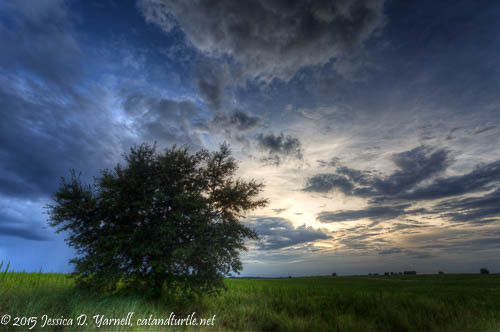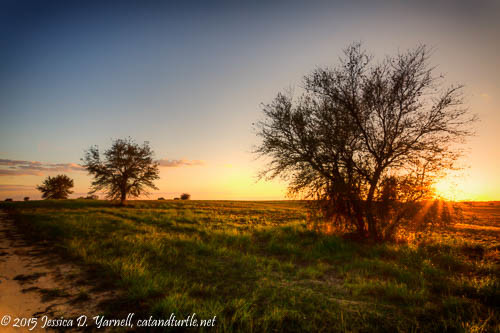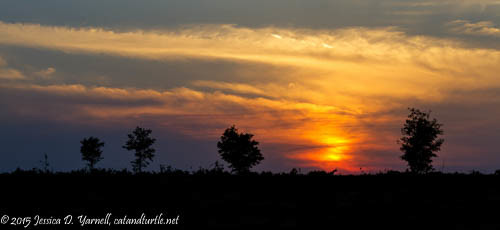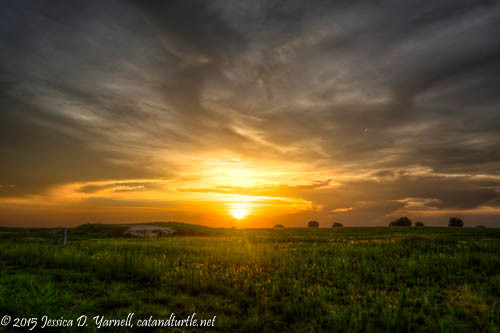For the past couple of years, I’ve been doing a little “Sunset Project” in the backroads near my house. I’ve read that the best way to study light is to make the same photograph every day for a whole year and observe how the light falls and the shadows change. Well, I couldn’t commit to a 365 day project with my work schedule, but I did try to get out there at least every couple of weeks. I’ll share them in an extra-long blog post to show how the landscape changes over the course of a year.
In the early spring the fields are green with fresh rainfall, but the grass isn’t very high. Cows roam on these fields to help keep them mowed. Sometimes the best sunset conditions are with some clouds, which catch the light of the setting sun and glow pink and blue and purple.


The grasses out have golden tops that glow as they are backlit by the setting sun. Sometimes the rays come down at a gorgeous angle and set the entire fields a-glow…

Here’s a close-up of one of the grasses.

Of course, it’s not always bright and sunny, not even in Florida! For the first couple months of my project, I went out only when I thought the weather conditions would be good. Then I realized that I should try some cloudy days, and I might be surprised at the results. I was! Some of my best images were from really poor weather days…

On this particular day, I learned an important lesson: Carry a cloth with you in your camera bag so you can wipe your lens when it starts to rain! Some of my best images from this day had huge water drops in the middle. Oops!
This next image looks over-processed, but the colors that night truly were this vivid. I was photographing one of my favorite trees and a break in the clouds started to glow. It was spectacular.

I tried making some vertical compositions, too. When the clouds stretch high into the sky, the verticals can be very dramatic.

But I think I preferred the horizontal, which showed more of the sunset skyline. I didn’t have enough good foreground elements to create “leading lines” into the vertical shots.

The lenses that I’m most comfortable with tend to be my telephoto zooms. Ask any of my photography friends – I love to zoom in. I’ll have my 2x teleconverter on when Michael is complaining that he has too much lens with no teleconverter at all! So it was a challenge for me to get comfortable with the wide angle lens.

You would think after photographing the same place so many times, I’d get bored with it. Not so much! If anything, this project taught me to see differently and look for a new angle in the familiar. For example, after photographing this tree all summer, I realized in the following spring that I could frame the sunset as the rays burst through the holes in the tree — but that shot is only possible in the early spring. After the late spring/early summer rains start and the tree leaves flush, the tree fills in to the point where this shot isn’t possible.

In December, when it’s frozen and snowy and icy in the rest of the United States, I’m fortunate to live in Florida where the grass is still green. I remember coming home from college in Pittsburgh and drinking in the green Florida landscapes on my Christmas vacations. But still, the photograph above shows how even the Florida landscape shows the effect of cold fronts and freezing temperatures. The fields aren’t as lush and the color of the light is different than in summer.

These December images were taken a day before the winter solstice. I hadn’t explicitly tried to go out on the solstice, but as I realized that I was so close to one, I wished I’d gone out on each solstice that year! Note to self for future projects… :)
By March, the fields have started to green up, but the trees haven’t yet filled out. A slight change in position makes the image look very different.

Hmm. I wonder how these fields would look covered in snow. Probably a sight I’ll never live to see!!

The blue-sky days started to turn boring. It felt like I was making the same image over and over again. So I started looking for new takes on the same landscape, and I pulled out my trusted telephoto lenses to do so.

On this particular night, the sky was devoid of clouds except at the horizon. The sun glowed brilliantly as a giant orange orb as it slipped beneath the treeline.

Here I used The Beast to silhouette several trees on the far horizon against the sun setting behind the clouds. These details would have been lost in my wide-angle lens. Here I walked along until I found just the right position to make a pleasing composition, with the sun filling a gap in the trees.

On other days, I tried to capture the golden light as it shone on the rippling grasses in the fields. I’ve yet to capture an image that accurately portrays the twinkle of the grasses as they sway in the breeze and catch the light of the fading sun. I’ve learned to use HDR post-processing techniques on my images to give them some “pop”. I try hard not to overdo that effect. For some images, like the “streak of light” photo from June, HDR is just the trick to getting the image on your screen to look like what you saw in real life.

Here I used my Beast again to frame the setting sun with the grasses in the foreground. Yay for the clouds that covered the sun and for LiveView that helped me compose the image quickly without looking through the viewfinder!

As my project came to a close, Rich asked me if I would continue going out there for sunset. I admit I haven’t gone as much, but I’m certainly ready to go. I’m curious to play with my 10-stop neutral density filter and see what I can do with some really long exposures. For that, the best day might be a really gray, nasty day!

This project is all the more special to me because the landscape is changing so quickly. Land is being cleared and cookie-cutter houses are going up faster than I can shoot a burst of continuous photos! The last time Rich and I drove down Highway 429, I looked around in disbelief, quoting Tolkien as I said to Rich, “But these trees were my friends! I’ve known them since nut and acorn!” I’m not sure how long my sunset paradise is going to last. But at least I have some beautiful images and great memories to share…

Want to learn more about nature photography at Lake County Backroads?
Check out my Lake County Backroads page with more information about the location, map, website, photography tips, etc. It is archived by date so you can see my images from previous visits. Maybe you'll be inspired for your own trip!
Planning a trip to Florida? Don't miss my Central Florida Bird Photography Locations reference guide!

4 thoughts on “My Sunset Project”
Very cute … nice sunset images too. Oh, and a nice touch with the burrowing owl. :-)
Great images and a fun project. Too bad the area is being developed. It is a gorgeous place for photography. And who is this Michael you mention that is always complaining? Surely not I! ?
Love this post! Thanks for sharing.
What a wonderful project! Fabulous images, especially that last one with a you-know-what in it!
Comments are closed.